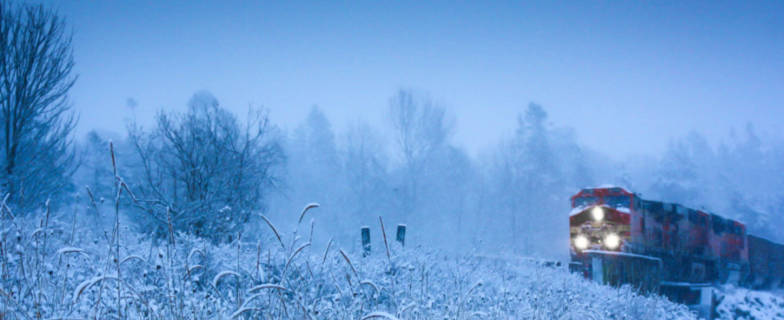Snow (and Railroad Worker) Falls: Safety Hazards and the Importance of Railroads Creating a Winter Action Plan under the FELA
Unlike many other industries, railroads rarely shut down during winter weather. Even in the harshest of winter conditions, when many other businesses are closed and families are huddled indoors, our nation’s railroaders brave the elements to keep America’s trains operational.
Snow, ice, and freezing temperatures present serious safety hazards for railroaders, including from conditions like frozen switches, slippery surfaces, impaired vision, and frostbite. Even though winter weather cannot be eliminated or controlled, the railroad is not automatically off the hook for related work injuries simply because bad weather was involved. Although the railroad will likely try to blame the weather instead of taking responsibility itself, most injuries are preventable, and the railroad still has a duty under the law to provide a reasonably safe workplace.
Accordingly, every railroad should have a winter action plan, including procedures for preparative maintenance, snow/ice removal, provision of adequate winter PPE, and implementation of safe work methods and related training for winter operations. Failure to create this type of winter action plan—and execute it—increases the risk of injury to workers. If an injury does occur under such circumstances, this can give rise to a claim under the Federal Employers’ Liability Act (FELA).
This article is intended to identify some of the hazards that you may encounter during the winter months, and reasonable steps the railroad should take to minimize or eliminate those hazards:
Preparative Maintenance
- When winter weather is predicted, special care should be taken to clear walkways of debris, which can become hidden tripping hazards in the snow.
- Drains and gutters should be checked to make sure that they are not blocked or leaking, which can result in the formation of frozen puddles or icicles that may fall and cause injury.
- The railroad should ensure proper drainage around switches, rails, and other work areas to prevent accumulation of ice.
- The railroad should ensure that it has plenty of snow and ice removal equipment in good working condition, including de-icing supplies like salt.
- The railroad should perform frequent track inspections in response to an increased likelihood of track defects due to extreme temperatures causing rails to expand and contract.
- The railroad shares responsibility for safe working conditions at industry facilities and should coordinate with its customers to ensure they also have adequate winter action plans.
Response After Snow/Ice
- As soon as reasonably possible, the railroad should remove snow/ice where employees are assigned to work, including on parking lots, walkways, steps, gates, switches, derails, and tracks. Relatedly, snow and ice can become compacted at crossings with heavy traffic or in flangeways, which can cause derailments if not cleared with special care.
- When removed, snow/ice piles should be placed an adequate distance from tracks, crossings, and other potential hazards so that they do not interfere with trackside duties or visibility.
- Railcars and other equipment should be cleared of built-up snow/ice.
- Salt and other de-icing agents should be used to prevent the thawing and re-freezing of snow/ice in areas that are traveled by employees.
- Winter mats and wet floor signs at the entrance of buildings can help prevent floors from becoming too slippery and serve as a reminder to use extra caution.
Provision of PPE
- Winter PPE should include appropriate footwear, including insulated, water-resistant boots with a non-slip tread and boot spikes. The railroad should also supply insulated, water-resistant gloves with adequate grip.
- Extreme cold can lead to trench foot, frostbite, hypothermia, and even death. When employees are expected to work outdoors for a lengthy period of time, the railroad should ensure there is a heated area to create a warm, dry place for short breaks.
- Railroaders should bundle up, wearing at least three layers of clothing, including long underwear and a winter hat that covers the ears, which reduces body heat escaping from the head.
Safe Work Methods/Training
- The railroad should ensure that its employees know what PPE is available and when it should be used; for example, boot spikes can increase traction in icy conditions but can also increase the risk of slipping on wet surfaces.
- The railroad should provide adequate written instruction and training for working in winter weather, including items like warming up/stretching to reduce cold-induced stiffness, taking shorter and slower steps for traction, and recognizing when PPE is worn out and/or should be replaced.
- Job briefings with crews should emphasize winter weather hazards and safe work methods.
When the railroad fails to take these types of reasonable steps, the risk of injury increases dramatically. If you suffer a work injury involving winter weather conditions, do not assume the railroad shares no responsibility or that you have no injury claim. If this happens to you, we highly recommend reaching out to a member of our national award-winning railroad injury team here at Schlichter, Bogard & Denton.
Article by Jon Jones, Associate
In our Railroad Injury e-newsletter exclusively covering railroad-related topics, attorneys from Schlichter Bogard & Denton’s nationally recognized team discuss, among other things, railroad workers’ rights, federal railroad laws, recent rulings impacting railroad workers, and firm news. Click here to subscribe.
The information contained in this newsletter is provided for informational purposes only and does not constitute legal advice. Reading this newsletter and information contained herein does not constitute formation of an attorney-client relationship. Every potential case must be assessed in accordance with its unique facts and circumstances. If you believe you may have a legal claim, please request a free, confidential case evaluation with our team today.
